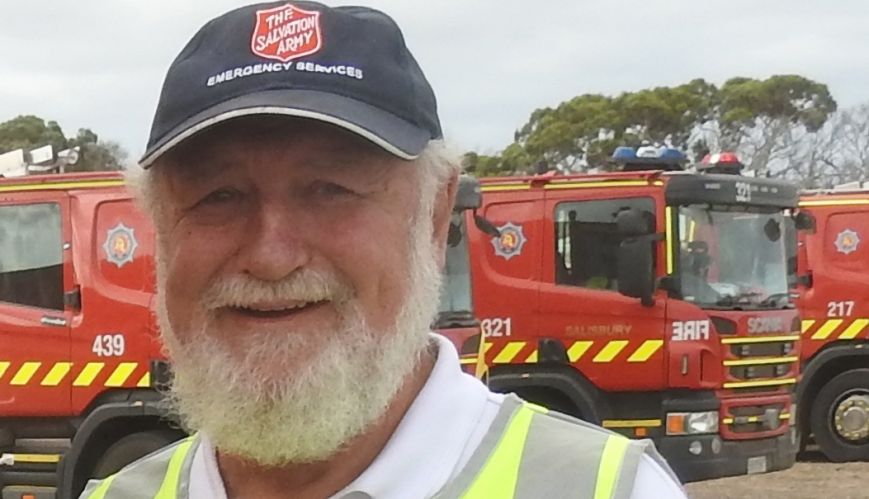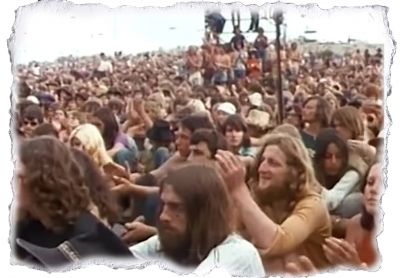Fire still in belly but Alan douses flames on SAES career

Fire still in belly but Alan douses flames on SAES career
13 March 2021
After 40 years of serving with The Salvation Army Emergency Services around the country, Alan Steven has reluctantly hung up the high-visibility jacket.
Although having been a corps officer for about 20 years and a carpenter before that, Captain Alan Steven says that a role within The Salvation Army Emergency Services (SAES) stream has been “part of his job description” for 40 years.
He is just beginning to realise what life will be like not being on the frontline at a disaster, crisis or event with the SAES.
Since having attended his first event as an emergency services representative at the Sunbury Pop Festival in January 1975 – ironically the last year the annual event was run – working in that area has been quintessentially Alan Steven: “After that, it got into my blood.”
 (From left) Strategic Emergency and Disaster Management Coordinator for South Australia Major David Boughton, former state coordinator Des Ellery, and Alan Steven.
(From left) Strategic Emergency and Disaster Management Coordinator for South Australia Major David Boughton, former state coordinator Des Ellery, and Alan Steven.
Alan, who attends Ingle Farm Corps in Adelaide, has served the SAES in Victoria, South Australia and Northern Territory, even sitting on state emergency services boards.
In South Australia, it has been bushfires, in Alice Springs it was “mainly people getting lost” and in Darwin it was cyclones. Alan has, as the saying goes, seen it all.
His last major event was helping out on Kangaroo Island when the island was engulfed in flames at the beginning of 2020 – as were many areas of Australia in what was one of the worst bushfire seasons the country has experienced.
He and the team of SAES volunteers had just returned from bushfires at Cudlee Creek, about 40km north-east of Adelaide, when they got the call to head to Kangaroo Island, which is off the South Australia coast.
“At Cudlee Creek, they were fighting the blaze on two fronts and so we set up a truck at either end of the fire,” Alan said. Two Adelaide-based food trucks equipped with two full commercial kitchens were dispatched. The team helped to feed, hydrate and attend to any other needs that fire crews and first responders had.
Alan said that at one point on Kangaroo Island, he was given minutes to evacuate his SAES command post as the firefront quickly approached. He was told to evacuate and leave the truck but, with the help of defence force personnel, “we packed up and moved within six minutes”.
It was during the Kangaroo Island emergency that Alan’s health deteriorated to the point where the decision was made for him that that event was to be his last on the frontline. Arthritis in his feet has reached a point where he finds it difficult to stand and walk: “I can’t drive the truck anymore and the ramp [into the rear of the SAES trucks] I find hard to climb.”
Officer service
Alan was born in Devonport, Tasmania. His family moved to Melbourne when he was nine so his parents could attend officer training college – in the last session of cadets before the course went from 10 months to two years.
He and his then-wife – “a Glenelg girl” – followed his parents into officership and enjoyed appointments at the now-closed Thornbury East Corps, Kaniva near the Victoria/South Australia border, Alice Springs, Darwin and Noarlunga, before their last appointment at South Barwon in Geelong, Victoria. For the next almost 20 years, he was the Director of Community Services at Ingle Farm Corps in Adelaide.
Alan was a carpenter and joiner before answering the call to officership, but many of his more refined works – mercy seats, holiness tables – can still be seen in a couple of corps around South Australia, he reveals proudly.
Having retired from most forms of work in 2016, Alan still loves to tinker with timber in the shed at his Valley View home in Adelaide’s north-east suburbs.
In an echo from the late United States president, Ronald Reagan, Alan has been invited to “put up this wall” at his beloved Ingle Farm, having made about 25 internal walls: “Most were demolished in our rebuild a few years ago, but I have built six walls even since the rebuild. I remodelled our platform in the main hall last year so plenty of carpentry [has kept him busy].”
 Where the SAES journey began for Alan Steven – the Sunbury Pop Festival on the outskirts of Melbourne in 1975.
Where the SAES journey began for Alan Steven – the Sunbury Pop Festival on the outskirts of Melbourne in 1975.
“I live pretty close to the SAES warehouse so they usually call me when someone wants to get in there as I’ve still got keys, Alan said.
Major David Boughton, South Australia’s Strategic Emergency and Disaster Management coordinator, said Alan had done “a mighty job” during last year’s fire season.
David said the state’s coordinator at the time, Des Ellery, was on leave interstate when the fires of 2019-20 broke out and “Alan stepped up and kept the show going”.
“Alan is a man of many talents, and last fire season while Des was away on family matters and the incoming coordinator was yet to transfer to South Australia, someone had to take charge, and Alan was the right man for the job.
“No one knew how big or how long the events of the 2019-20 fire season were going to last and, while many people stepped up to volunteer, the overall leadership of this fell on the shoulders of just a few. Alan and his wife, Robyn, were two who took most of this on,” David said.
The SAES around the country needs more volunteers to fill the shoes of people such as Alan. David said SAES volunteers were aging and, in many instances, ill-health, COVID-19 restrictions and the demands of serving long hours in harsh environments had “taken their toll”.
“It is difficult for younger people with work or other commitments to just drop everything at a moment’s notice to service with SAES to assist those on the frontline; however, as volunteers like Alan need to step away, the question is: “Who IS going to fill the shoes of all those who have given so much over many, many years?”